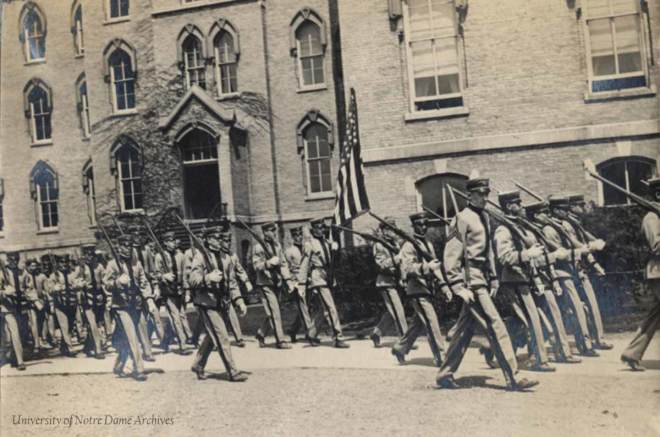Engraved deep into the stone on the side door of the Basilica of Sacred Heart Church at Notre Dame are not merely words but a way of life: “God, Country, Notre Dame.”
It weaves together the school’s spiritual and patriotic elements while enjoining its loyal sons and daughters who are, as the Victory March states, “strong of heart and true to Her name.” The relationship between the military and Notre Dame goes far beyond football rivalries with Army West Point, Navy and Air Force
“Ever since 1858 when the student-organized Continental Cadets began marching across campus in their blue and buff American Revolutionary-style uniforms, Notre Dame has been teaching students how to be good soldiers,” wrote John Monczunski in the Spring 2001 Notre Dame Magazine.
“Fair Catch” Corby
While most Notre Dame enthusiasts are aware of the “Touchdown Jesus” mural on the Hesburgh Memorial Library, plus the mammoth “We’re No. 1 Moses” statue on the west side of the library, the history behind the “Fair Catch Corby” statue is not as well known.
Father William Corby was a 30-year-old priest who served as the chaplain of the famous Irish brigade that fought Civil War (1861-65) battles from the First Bull Run to Appomattox.
It was during the bloody July 1-3, 1863 battle in Gettysburg, Pa., where more than 46,000 troops from the Union and Confederacy were killed, wounded, captured or ended up missing, that Corby led his men in prayer and pronounced general absolution.
A picture of the dramatic event, with the battle raging in the background, was taken with Corby delivering the absolution with his right hand raised — similar to a fair catch in football. In 1910, 47 years later, sculptor Samuel Murray shaped a bronze statue of Corby that was placed at the spot in Gettysburg where Corby delivered the absolution. A duplicate stands outside Corby Hall, next to Sacred Heart Church, on the Notre Dame campus.
After the war, Corby served as Notre Dame’s president from 1866-72 and 1877-1881, prior to his 1897 death.
Seven other Notre Dame priests joined Corby as chaplains in the War Between the States, and 89 Holy Cross sisters left Notre Dame and Saint Mary’s College to serve as nurses during the Civil War. Two generals for the Northern Army came from Notre Dame — Williams F. Lynch and Robert W. Healy.
Healy would work with General William T. Sherman, whose march through Georgia rivaled Gettysburg as the most devastating campaign of the war. What is not as well known is that while Sherman was marching through the South, his wife and children were living at Notre Dame. Two of his boys were also enrolled at the minim department of the University.
A third son, died as an infant during the course of the war and was buried in Notre Dame’s community cemetery, according to Don Heltzel in the Feb. 28, 1941 Notre Dame Scholastic.
The Legend Of ‘Shilly’
As president of Notre Dame, Corby instituted military training at the school in 1880, and two years later the program offered academic credit.
The Spanish-American War in 1898 also had a Notre Dame tie. In 1897, Notre Dame student John Shillington participated in a baseball game for his school in his hometown of Chicago, and he remained there while the team returned home. This led to his expulsion, and in his sorrow he joined the Navy.
He was assigned to the Battleship Maine. There, according to Arthur J. Hope C.S.C., author of “Notre Dame — One Hundred Years, ” the popular former student wrote to a Notre Dame friend: “I often think of Notre Dame, I can picture her daily, and in my reminisces of her, a tear is often brushed away. I suppose ‘Shilly’ is forgotten by people at the old college, and I don't blame them. Though forgotten, I shall always hold Notre Dame near and dear to me.”
Not long thereafter, Feb. 15, 1898, the Maine, sent to Havana, Cuba to protect U.S. interests in a Cuban revolt against Spain, exploded. It killed Shillington, and precipitated the Spanish-American War.
Notre Dame took a personal stake in the tragedy, and a campus monument is dedicated in his memory.
By the onset of World War (1914-18), Corby’s military training implementation had become a requirement for most Notre Dame students, and in 1917 its application for the government’s Student Army Training Corps (SATC), the precursor to today’s Reserve Army Training Corps (ROTC), was accepted.
The United States didn’t partake in World War I until 1917. Approximately 2,200 Notre Dame students entered the uniformed service, and 46 were killed in action. Their names are the ones memorialized at the “God, Country, Notre Dame” entrance.
Tomorrow: Part II includes World War II, the Navy saving Notre Dame, and Rocky Bleier in Vietnam.
University of Notre Dame Archives




إرسال تعليق